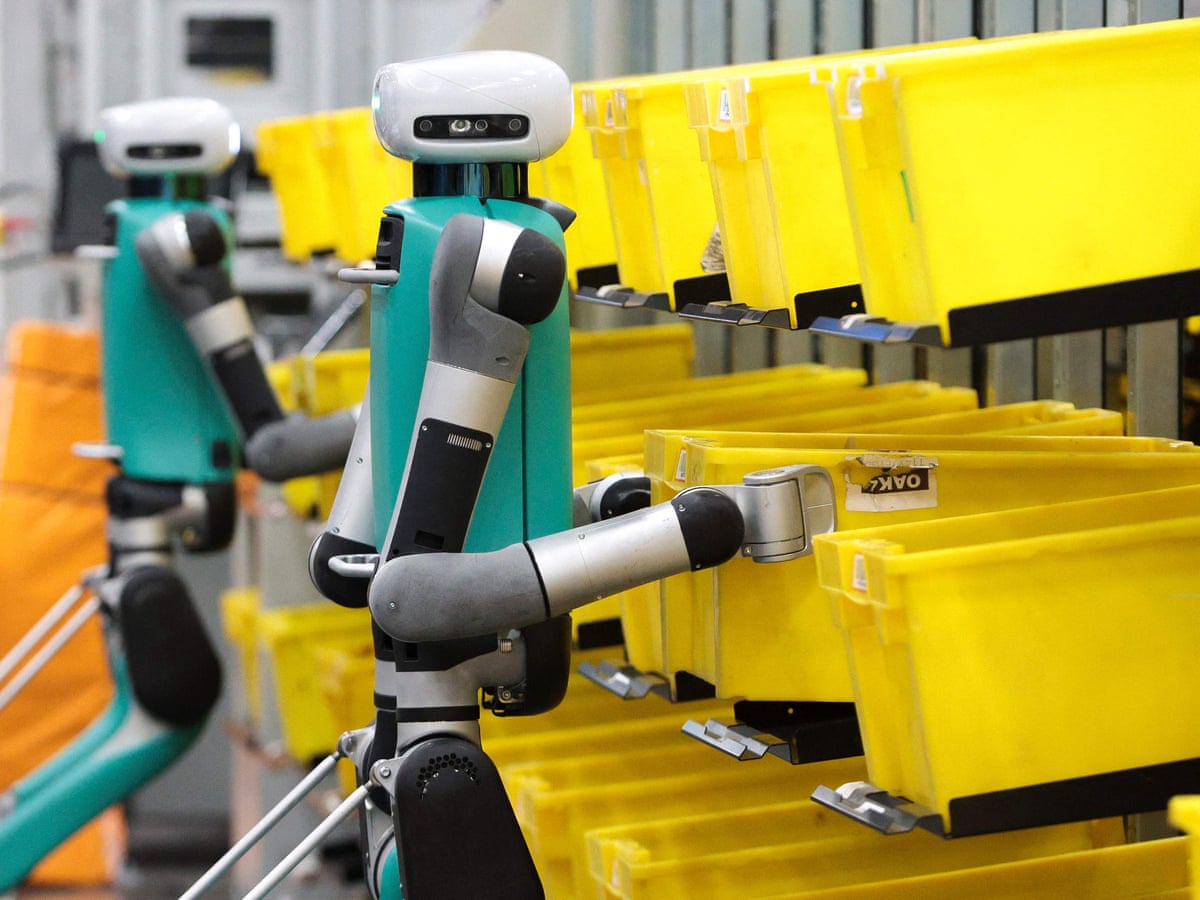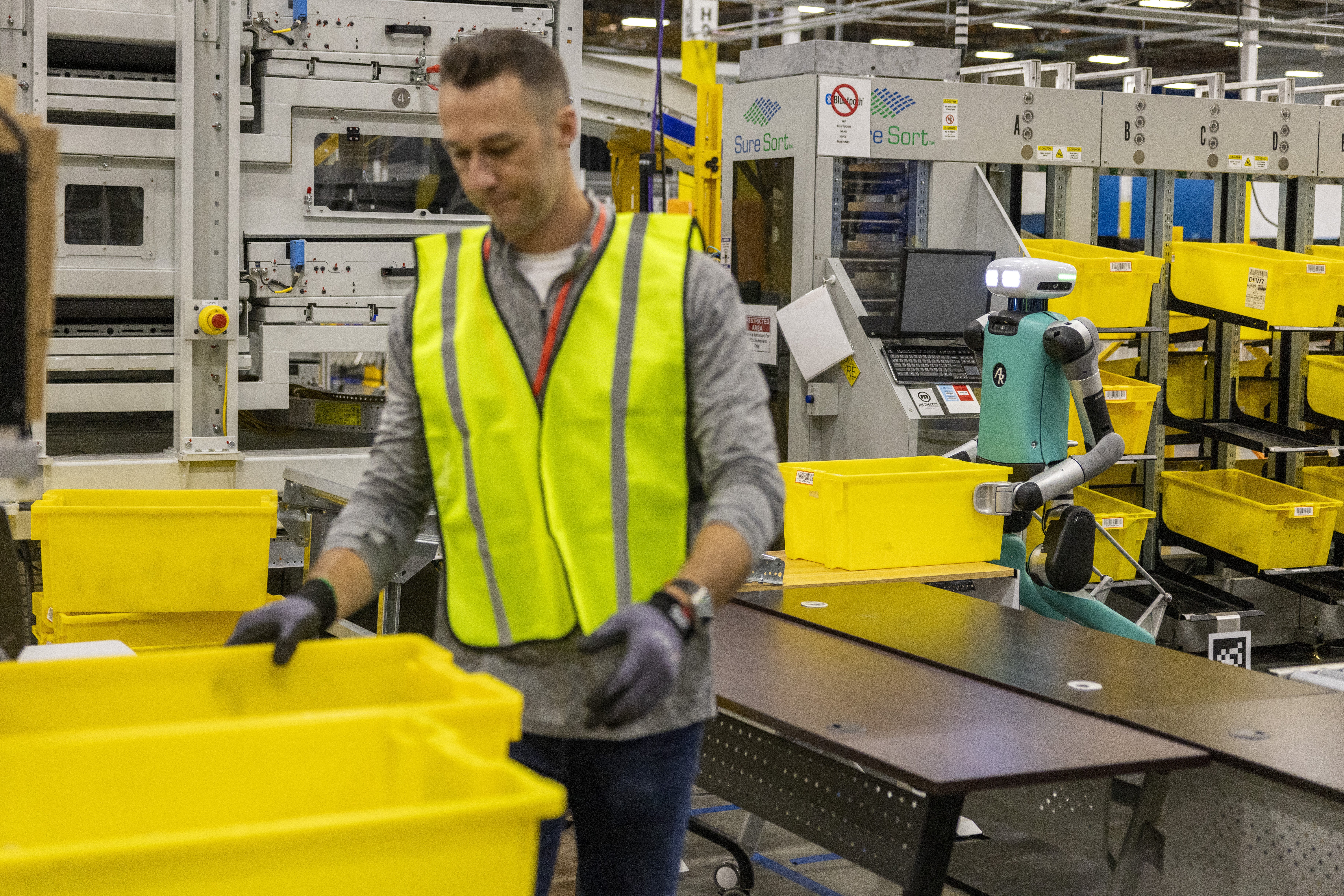Amazon Testing Humanoid Robot ‘Digit’ In Warehouses: Redefining Workforce Dynamics in the Digital Age!
Amazon has started testing Humanoid Robot Digit in its US warehouses to redefine workforce dynamics and take over employee handled tasks.

Amazon Testing Humanoid Robot ‘Digit’ In Warehouses: Redefining Workforce Dynamics in the Digital Age!
The largest e-commerce company in the entire world, Amazon, is actively testing humanoid robots in its US warehouses in a huge step toward automation. The business recently revealed Digit, a cutting-edge robot that will execute jobs that were previously only performed by human workers.
A Giant Leap in Automation
Digit, created by Agility Robotics with support from Amazon, is 5 feet 9 inches (175 cm) tall and 143 pounds (65 kg) in weight. Digit is unique in that it has the capacity to kneel, mimicking human movements, as well as walk in three different directions at once—forward, backward, and sideways. The robot can pick up and move various goods, including parcels, containers, customer orders, and other objects, just like a human worker would. It has a carrying capacity of as much as thirty-five pounds (16 kg).

Addressing Concerns and Creating Opportunities
Concerns over the possibility of human workers losing their jobs as a result of this automation trend have been voiced. The major loss of jobs was raised by Stuart Richards, a trade unionist with the UK’s GMB, who said, Amazon’s automation is leading to a considerable loss of jobs. In their fulfilment centers, hundreds of positions have already disappeared.
However, Amazon has addressed these worries by focusing on the creation of new employment possibilities. According to the business, its robotic systems have created “hundreds of thousands of new jobs,” which includes the creation of 700 new job categories, some of which are skilled roles that were not previously present within the business. These developments, in the words of Amazon, “free employees up to better deliver for our customers.”
Humans Remain Invaluable
The chief technology officer of Amazon Robotics, Tye Brady, emphasized the value of human workers as being irreplaceable. There is no part of me that believes that totally automated warehouses will ever become a reality, he said, dispelling the idea. People are so important to the fulfilment process because they have higher-order thinking capacity and problem-solving skills. Amazon continues to stress the collaborative efforts between human employees and technology, even though the inclusion of robots like Digit signals a step forward in automation.
The business is certain that these developments will boost productivity as well as offer workers more chances to work on challenging, high-level projects. Amazon’s unwavering quest of innovation has resulted in the use of ground-breaking robotic technology in its warehouses, with the goal of transforming the e-commerce sector. Despite the potential prospects of automation, questions have been raised about the treatment of Amazon’s warehouse workers, citing difficult working conditions as well as elevated turnover rates.
Striking a Balance In The Operating Environment
In Amazon’s operating environment, the introduction of robots such as Digit has sparked discussions about the future of work in the face of automation. Because of the rising use of robotic technology, labour organizations have expressed concern with regard to the possible loss of employment. Amazon claims, however, that the incorporation of these technologies has produced a large number of brand-new employment categories. In order to tackle repetitive activities, the corporation has set up over 750,000 robots that collaborate with human workers. This highlights the crucial part that human workers play in the fulfilment process.

Digit: A Step Towards the Future
Digit, a cutting-edge robot with legs that can negotiate obstacles such as steps and stairs, is at the leading edge of Amazon’s robotic initiatives. Digit’s capacity to walk on two legs and utilize arms to carry packages and objects, in contrast to traditional wheeled robots, represents a significant leap. Digit is a prototype created to test the integration of mobile robots as well as manipulators in the Amazon environment, as explained by Scott Dresser from Amazon Robotics. He highlighted that the purpose of the continuing testing is to see how well and safely the robot will get along with human workers.
The Human Touch in Automation
Tye Brady, chief technologist at Amazon Robotics, reaffirmed the indispensable importance of human labour as well as emphasized their capacity for higher-order reasoning and problem-solving. He scoffed at the idea of fully automated warehouses, pointing out even modern innovations like Digit need human interaction for upkeep as well as repairs. Brady asserts that, based on Amazon’s experience, these technologies promote development and expansion by creating new employment rather than displace existing ones.
Beyond the Warehouse: Amazon’s Vision
Amazon has automated more than just warehouse operations. The business has started using wheeled robots to move things around its facilities as well as has started using drones to deliver packages in some parts of the US. By the end of 2024, Amazon wants to expand drone deliveries to Italy and the United Kingdom. This will allow for more efficient delivery as well as greater customer satisfaction.
Amazon is dedicated to striking a balance between innovation as well as the welfare of its workforce even as it pushes the limits of technology with robots like Digit. In the words of Amazon, the incorporation of automation is not intended to replace people but rather to improve their capabilities, open up new opportunities, and guarantee a sustainable future for both technology as well as the labour.

Navigating the Future: Humans and Robots in Amazon
Amazon’s recent advances in warehouse automation, as emphasized in articles concerning the humanoid robot Digit as well as the company’s continued initiatives, represent a paradigm change in the e-commerce business. The incorporation of these advanced robotic systems into Amazon’s operational framework has provoked heated debate and speculation about the future of human employment as well as the ethical implications of such technical breakthroughs. On the one hand, the incorporation of robots such as Digit offers better efficiency, lower operational expenses, as well as higher productivity.
These technical wonders are capable of managing repetitious activities and navigating challenging surroundings, reducing the possibility of human errors. The question, nevertheless, remains large: Will this automation eliminate human jobs? A glimmer of optimism comes from Amazon’s assertions that these technologies encourage growth as well as the emergence of new employment categories. It proposes that humans and robots may coexist in a symbiotic partnership where technology enhances human abilities rather than completely replacing them.
The Human Touch in a Digital World
The claim made by Tye Brady regarding the irreplaceability of human workers adds a significant aspect to this discussion. Even in the face of the most cutting-edge robotic breakthroughs, human intelligence, problem-solving abilities, as well as emotional intelligence continue to be unmatched. While machines like Digit are capable of performing physical tasks, humans’ complex decision-making processes as well as adaptability are essential. Therefore, the difficulty is in finding a balance where technology improves rather than limits human potential.
The Road Ahead: Challenges and Ethical Considerations
Ethical issues become more important as Amazon keeps experimenting with automation and robotics. It is crucial to protect human workers’ welfare in the midst of this technological change. These activities should include measures to minimize job relocation, adequate training, as well as upskilling programs. Furthermore, it becomes necessary to treat both human and artificial workers ethically. It is immoral to ignore the ethical imperatives of providing fair salaries, secure working conditions, as well as regular maintenance for robots such as Digit.
Embracing a Collaborative Future
The answer to traversing this unfamiliar environment is to embrace a collaborative future in which people as well as robots work together hand in hand. When tackled wisely as well as ethically, automation has the ability to modernize sectors while safeguarding labour dignity. Amazon’s robotics initiatives, such as Digit, offer a tremendous improvement not only in technological advancement, but also in changing the interaction between humans and machines. Moving forward, the emphasis must be on supporting innovation that increases human potential, produces meaningful employment, as well as secures a future in which people and robots coexist in harmony.





